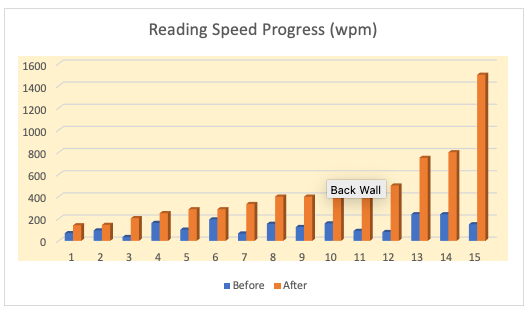


Some of our approved coaches are doing amazing work with children, and our evidence base is growing. Fifteen children, aged between 8 and 17 have now completed Visual Reading. Initial reading speeds ranged between 35 and 240 words per minute (wpm) with a median score of 125 wpm (mean 131 wpm). Speeds rose to 141 to 1500 wpm, with a median score of 400 wpm (mean 461 wpm). This has high statistical significance despite the small group (p<0.001)

Here, we can see that every child made significant progress. To provide context, 190 wpm is the mean ‘reading for meaning’ speed for postgraduate readers, while their ‘average range’ is from 131 to 248 wpm.
There is also little correlation between starting and final speeds (r=0.34) which can be interpreted as explaining just 11% of the progress made.
Now 13 of these children are reading faster than the mean ‘reading for meaning’ speed of postgraduates, 12 are above the ‘average range’ for postgraduates, and 9 are in the top 1%. These reading speed achievements are not at the expense of comprehension which has, in all cases, shown improvement, in many cases dramatically so.
If we measure their progress in Standard Deviations (compared to postgraduate readers), this mean improvement represents 5.6 Standard Deviations. In their general learning, on average, children tend to make 0.5 Standard Deviation improvement over an academic year. This is often attributed to growing maturity as much as a measure of learning. So 5.6 Standard Deviations in about half a term is, as far as we can see, an unprecedented achievement.
Of course, measures of reading speed and comprehension give no indication at all about the positive impact on self-esteem and self confidence that being an excellent reader confers on dyslexic children. As one of them said, “Reading is now my superpower!”.